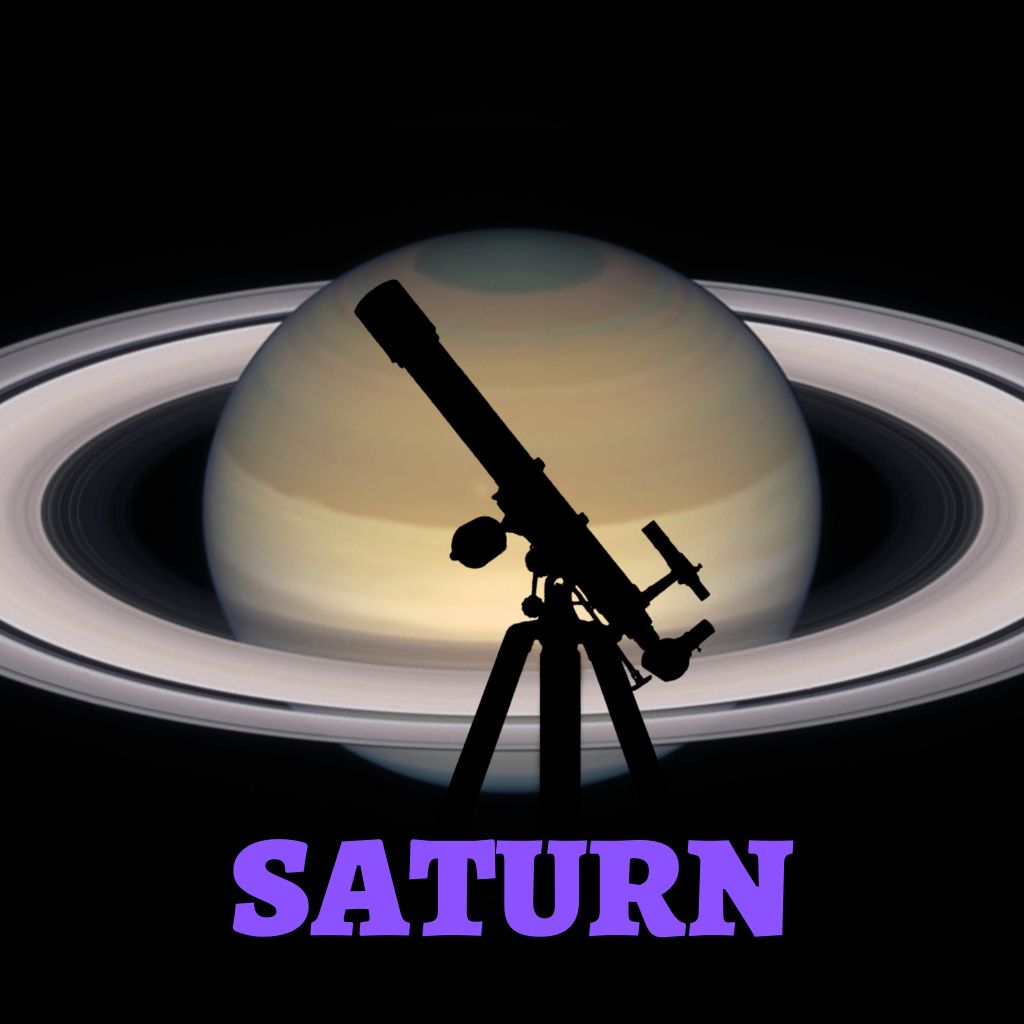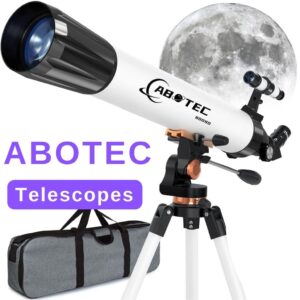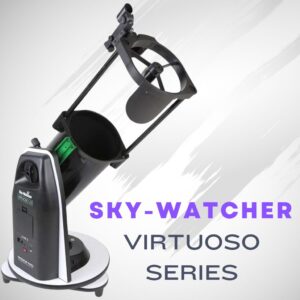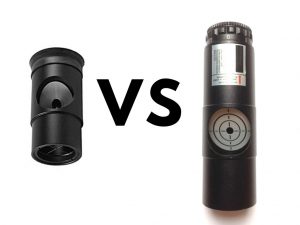This site contains affiliate links to products. I may receive a commission for purchases made through these links.
You will need a telescope with a minimum of a 4-inch aperture to see Saturn clearly through a telescope. However, larger aperture telescopes will provide a much clearer and more detailed view of the planet and its iconic rings.
Saturn, the sixth planet from the Sun and the second-largest planet in our solar system is a breathtaking sight to behold. Many stargazers dream of seeing it up close.
In this article, we will explore the different telescope sizes that can be used to view Saturn and what to consider when choosing the right one.
What is the best telescope size for viewing Saturn?
For viewing Saturn, a telescope with an aperture size of at least 4 inches is recommended. A 6-inch or 8-inch telescope is even better as it provides brighter and clearer images of the planet.
In addition to aperture size, the quality of the optics and the type of telescope also play a role in viewing Saturn.
Refractor telescopes with good-quality lenses are ideal for planetary observation, while reflector telescopes with large mirrors can also provide excellent views.
Below are some recommended telescope sizes for observing Saturn, ranging from 4 to 8 inches:
Celestron NexStar 4SE
The Celestron NexStar 4SE is a popular 4-inch telescope for beginners and intermediate astronomers. It has a 4-inch aperture and a focal length of 1325mm, which provides clear and bright images of Saturn.
It comes with a computerized GoTo mount, which helps you locate Saturn easily. The telescope also has a built-in camera, which allows you to take photos and videos of Saturn.
You may also: Celestron NexStar 4SE Review
PolarLink 102EQ (4inch) Refractor Telescope
The PolarLink 102EQ is a 4-inch refractor telescope designed for astronomy enthusiasts looking for a high-quality instrument to observe celestial objects.
With a 102mm aperture and 660mm focal length, this telescope delivers excellent light-gathering ability and produces clear and bright images of Saturn and other planets.
One of the notable features of the PolarLink 102EQ is its manual German equatorial mount, which provides smooth and precise movements for easy tracking of Saturn as it moves across the night sky.
Celestron – StarSense Explorer DX 102AZ Smartphone App-Enabled Telescope
The Celestron – StarSense Explorer DX 102AZ Smartphone App-Enabled Telescope is a great option for beginners and casual observers who are interested in viewing the Moon, planets, and other celestial objects, including Saturn.
The 4-inch aperture provides detailed and clear images of Saturn and its rings.
Its smartphone app-enabled technology makes navigating the night sky easy and locating Saturn quickly.
Celestron NexStar 6SE telescope
The Celestron NexStar 6SE telescope is a highly popular and versatile instrument that is capable of providing excellent views of Saturn. This telescope offers impressive resolution and image quality with a 6-inch aperture and a focal length of 1500mm.
It features Celestron’s patented SkyAlign technology, making it easy to align and locate celestial objects like Saturn.
The telescope also includes a computerized GoTo mount, allowing for precise tracking and automatic alignment.
Sky-Watcher Classic 150 Dobsonian 6-inch Aperture Telescope
The Sky-Watcher Classic 150 Dobsonian telescope is a 6-inch aperture reflector telescope that is designed for both beginners and experienced astronomers.
It features a sturdy and stable wooden Dobsonian base with smooth azimuth and altitude bearings, which makes it easy to track celestial objects like Saturn.
The 6-inch aperture provides a bright and clear view of Saturn’s rings, and the easy-to-use design makes it a great option for anyone looking to observe the planet and other celestial objects.
Orion Skyline 6″ Dobsonian Reflector Telescope
The Orion Skyline 6″ Dobsonian Reflector Telescope is a powerful telescope with a 6-inch aperture that gathers plenty of light, allowing for clear and bright images of celestial objects such as Saturn.
The Dobsonian mount is easy to use and allows for smooth movement of the telescope, making it an ideal choice for beginners.
The sturdy construction of the telescope ensures that it will last for many years of stargazing.
With its simple design and powerful optics, the Orion Skyline 6″ Dobsonian Reflector Telescope is an excellent choice for those looking to observe Saturn and other celestial objects.
Celestron Advanced VX 6″ Schmidt-Cassegrain Telescope
The Celestron Advanced VX 6″ Schmidt-Cassegrain Telescope is an exceptional instrument for observing celestial objects, including Saturn.
With its advanced optics and precision engineering, this telescope provides crystal-clear images of the ringed planet, even from light-polluted areas.
The 6-inch aperture and 1500mm focal length ensure that you get bright and detailed views of Saturn’s cloud bands, the Cassini Division in its rings, and its bright moons, such as Titan and Enceladus.
The telescope’s sturdy mount and tripod offer smooth and stable tracking of celestial objects, making it easy to keep Saturn in view, even at high magnifications.
Celestron NexStar 8SE Telescope
The Celestron NexStar 8SE is an 8-inch Schmidt-Cassegrain telescope that is well-suited for observing Saturn. It features Celestron’s StarBright XLT coatings, which help to enhance light transmission and image clarity.
The telescope’s computerized GoTo mount allows for easy tracking of Saturn as it moves across the night sky, and the included StarPointer finderscope makes it easy to locate Saturn in the first place.
The 8SE also includes Celestron’s SkyAlign technology, which simplifies the alignment process and helps to ensure accurate tracking throughout the night.
Sky-Watcher Classic 200 Dobsonian Telescope
The Sky-Watcher Classic 200 Dobsonian Telescope is an 8-inch aperture telescope providing an excellent viewing experience for beginner and intermediate-level astronomers.
The large aperture allows for a clear and bright view of Saturn and other celestial objects. Its Dobsonian mount provides smooth and easy movement and tracking, allowing for precise adjustments to focus on the planet.
The telescope also includes a 2-inch focuser and two eyepieces for versatile viewing options.
The Sky-Watcher Classic 200 Dobsonian Telescope is a great option for those looking for an affordable yet powerful telescope for observing Saturn and other celestial objects.
Orion Skyline 8″ Dobsonian Reflector Telescope
The Orion SkyLine 8″ Dobsonian Reflector Telescope is a powerful and versatile instrument that offers excellent performance for observing Saturn and other celestial objects.
With its 8-inch aperture, this telescope gathers a significant amount of light, which allows for sharp and detailed views of Saturn’s rings, moons, and cloud bands.
The sturdy Dobsonian mount provides a stable platform for the telescope, making it easy to point and track objects in the night sky.
Meade Instruments LX90-ACF 10-Inch Telescope
Meade Instruments LX90-ACF 10-Inch Telescope is a high-end telescope with a large 10-inch aperture, making it ideal for observing Saturn and its rings in clear detail.
The telescope features Meade’s Advanced Coma-Free (ACF) optics, which provide clear, distortion-free images across the entire field of view. This makes it ideal for observing celestial objects like Saturn and its rings, as well as other deep-sky objects.
It also comes with an advanced computerized mount and a range of accessories, including two eyepieces and a Barlow lens.
Don’t let a small telescope limit your stargazing adventures – with the Meade Instruments LX90-ACF 10-Inch Telescope, even amateur astronomers can enjoy breathtaking views of Saturn’s largest moon, Titan.
What are the best tools for Saturn observation?
Image Credit: NASA
Observing Saturn can be a fascinating experience, and while a good telescope is crucial, there are also other tools that can enhance your viewing experience.
Here are some of the best tools for Saturn observation apart from telescopes:
Barlow lens
A Barlow lens is an optical accessory that can be used with a telescope’s eyepiece to increase magnification. It works by increasing the effective focal length of the telescope, which in turn increases the magnification of the image.
Barlow lenses come in different magnification factors, typically 2x, 3x, or 5x. They are a cost-effective way to get closer views of Saturn’s rings and moons without having to invest in a new high-power eyepiece.
However, it’s important to note that using a Barlow lens can also decrease the image quality, especially if the lens is of low quality. Therefore, choose a high-quality Barlow lens from a reputable manufacturer such as:
- Celestron X-Cel LX 2x Barlow Lens: This Barlow lens has a 2x magnification factor, and its fully multi-coated optics provide sharp and clear images. It is compatible with most telescopes and eyepieces.
- Tele Vue 2x Barlow Lens: This Barlow lens has a 2x magnification factor and uses multi-coated high-index glasses for improved image quality.
- GSO 2x ED Barlow Lens: This Barlow lens has a 2x magnification factor and features extra-low dispersion (ED) glass for improved image quality. Its barrel is threaded for filters and compatible with most 1.25-inch eyepieces.
You may also like: The Best Barlow Lens For Any Telescope
Planetary filters
Planetary filters are optical filters that can enhance the view of specific features on Saturn’s surface. These filters work by selectively blocking certain wavelengths of light and allowing others to pass through.
This enhances the contrast and details of the planet’s features.
For instance, blue filters can enhance the cloud belts on Saturn, while red filters can highlight its polar regions.
Some recommended planetary filters for observing Saturn include the Baader Planetarium Contrast Booster Filter. This filter enhances the contrast and details of Saturn’s cloud bands.
The Celestron #12 Yellow Filter is ideal for viewing Saturn’s atmospheric features, such as the Cassini division.
Another option is the Orion 5562 SkyGlow Astrophotography Filter, which reduces light pollution and enhances the visibility of Saturn’s details and colors.
You may also like: Telescope Filters: Models & Types to Enhance Your View
What magnification is needed to see Saturn?
A minimum magnification of 25x is recommended to see Saturn and its rings. However, for a more detailed view of the planet’s features and its rings, a magnification of 50x or higher is needed.
Keep in mind that the quality of the telescope and the atmospheric conditions can also affect the clarity of the view.
You may also like: What Magnification Do You Need To See Planets?
What telescope is best for viewing Saturn’s Rings?
The best telescope for viewing Saturn’s rings will depend on several factors, but generally, a telescope with a larger aperture is better for this purpose. A minimum aperture of 3 inches (70mm) is recommended, but larger apertures, such as 4 inches (100mm) or more, will provide better views.
Additionally, a telescope that can provide a range of magnifications, ideally from 25x to 200x or higher, is recommended for more detailed views of Saturn’s rings.
Some popular telescopes to see Saturn’s rings include:
- Meade Infinity 80mm Refractor Telescope: This telescope has a 3.2-inch aperture and is a great entry-level option for those who are new to astronomy. It provides clear, sharp views of Saturn’s rings and other celestial objects.
- Orion SkyQuest XT6 Classic Dobsonian Telescope: This telescope has a 6-inch aperture and is a great option for those looking for a good balance of portability and performance. It provides bright views of Saturn’s rings.
- Orion StarMax 90mm TableTop Telescope: This telescope has a 3.5-inch aperture and is a compact tabletop option that is great for those with limited space. Despite its small size, the Orion StarMax provides clear, detailed views of Saturn’s rings.
The ring system of Saturn is a mesmerizing sight to behold. With the above telescopes, you can observe the incredible features of the rings of Saturn in clearer detail.
You may also like: How Big of a Telescope Do You Need to See Saturn’s Rings?
FAQs about the ringed planet Saturn
Let’s look at some frequently asked questions about Saturn
What is the position of Saturn in the sky?
Saturn’s position in the sky varies throughout the year as it orbits the Sun. It can be found in the constellation of Capricornus from 2021 to 2023, and then it will move into the constellation of Aquarius.
The best time to view Saturn is during its opposition when it is closest to Earth and appears brightest.
What is the size of Saturn when viewed through a telescope?
Saturn’s size, when viewed through a telescope, will depend on the magnification of the telescope and atmospheric conditions. Saturn is a giant gas planet, the second-largest planet in our solar system after Jupiter.
With a radius of 36,183.7 miles (58,232 kilometers), Saturn is about 9 times wider than Earth, making it one of the largest planets in our solar system.
Its immense size also means that it has a much greater mass than Earth – about 95 times bigger than Earth’s mass. But through a telescope, it may appear much smaller.
However, Saturn’s rings can make it appear larger, and viewing them is a spectacular sight.
Can I view Saturn with an 80mm telescope?
You can view Saturn with an 80mm telescope. However, the quality of the view will depend on various factors such as magnification, atmospheric conditions, and light pollution.
With an 80mm telescope, you will be able to see Saturn and its rings. However, the view may not be as sharp and detailed as what you would see through a larger telescope with a bigger aperture.
To optimize your viewing experience, using a high-quality eyepiece and observing Saturn from a location with minimal light pollution is best. It’s also important to be patient and allow your eyes to adjust to the darkness for several minutes before observing.
Takeaway: Observing Saturn with a suitable telescope size will give you a beautiful experience
Viewing Saturn through a telescope can be a truly inspiring experience. A good rule of thumb is that larger aperture telescopes provide clearer and more detailed views of Saturn.
Additionally, using the right tools and magnification can enhance the observing experience.
When you understand what telescope size and tools to use and where and when to observe, you can enjoy the beauty of Saturn.
You may also like:














